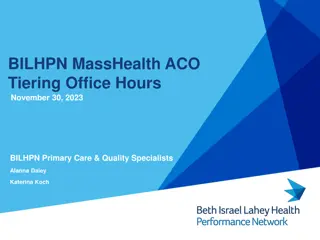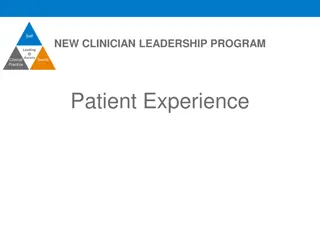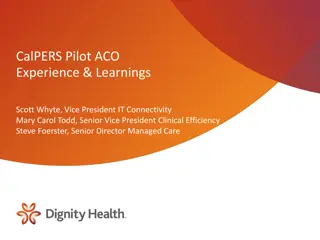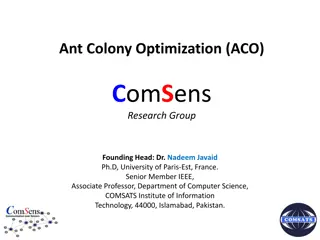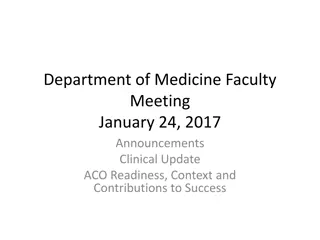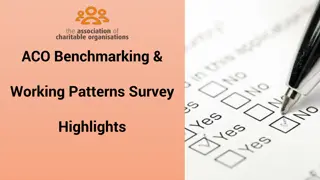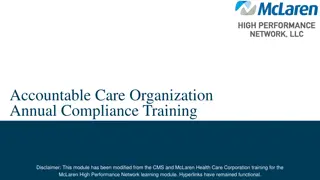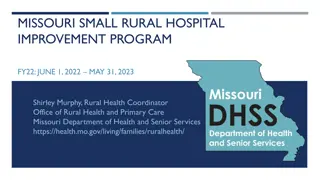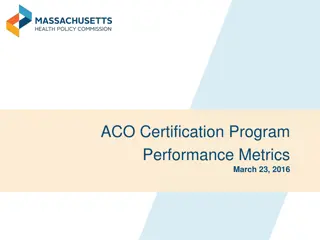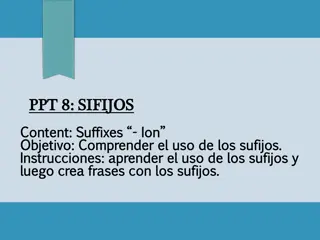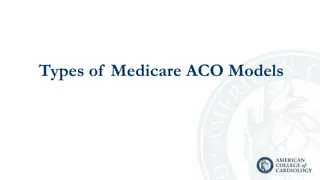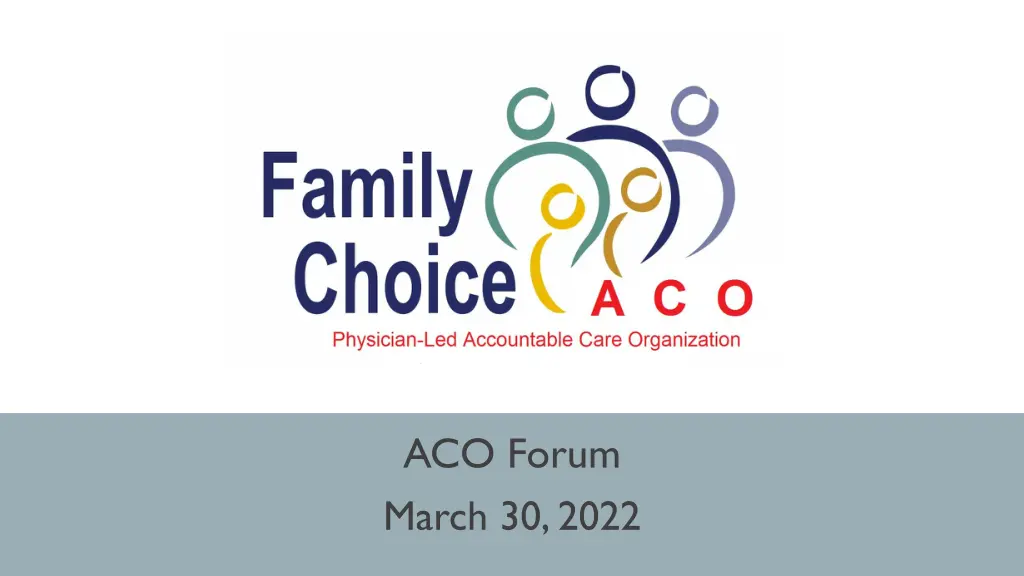
ACO Forum and Quality Care Initiatives - March 30, 2022
Explore the ACO Forum held on March 30, 2022, focusing on quality care measures, chronic care management, hospitalist programs, shared savings distribution plans, and key quality measures in healthcare. Learn how Patient Care Coordinators and Data Analysts assist in enhancing patient outcomes and promoting community health.
Download Presentation

Please find below an Image/Link to download the presentation.
The content on the website is provided AS IS for your information and personal use only. It may not be sold, licensed, or shared on other websites without obtaining consent from the author. If you encounter any issues during the download, it is possible that the publisher has removed the file from their server.
You are allowed to download the files provided on this website for personal or commercial use, subject to the condition that they are used lawfully. All files are the property of their respective owners.
The content on the website is provided AS IS for your information and personal use only. It may not be sold, licensed, or shared on other websites without obtaining consent from the author.
E N D
Presentation Transcript
ACO Forum March 30, 2022
CMS Programs ACO MSSP 1+ ACO Next Gen ACO Enhanced Primary Care First (PCF) Direct Contract Entities (DCE) ACO Realizing Equity, Access and Community Health (REACH) ACO Forum March 30, 2022
Quality Measures Team of Patient Care Coordinators (PCC) & Data Analysts to assist in closing all the Gaps in Care. MIPS Reporting Exemption from reporting. FCACO submit MIPS Reporting. QUALITY MEASURES, MIPS, & APM Alternative Payment Models (APM) Providers receive directly from CMS 5% of prior year of paid claims. 3
CHRONIC CARE MANAGEMENT (CCM) Patient Care Coordinators (PCC) outreach to all attributed members on a monthly basis. PCPs provide to FCACO PCCs updated demographic members list. (I.E. phone numbers and addresses)
HOSPITALIST PROGRAM FCACO PCCs, notify providers upon patient s admissions and discharges from ER or hospital. Post Acute Care Services provided by PCPs within one week from discharge. PCPs have option to follow up with patients in SNFs or Nursing Homes. PCPs are able to admit their own patients to hospital care, inpatient services.
Three-part shared savings distribution plan 1. HCC coding recapture 2. Quality performance 3. ACO Program Participation CCM opt in CCM In-house Billing opt in ACO Hospitalist opt in PROVIDER PERFORMANCE AND EVALUATION 6
ACO -13: Falls: Screening for Future Falls ACO - 14: Influenza Immunization ACO - 17: Tobacco Use: Screening and Cessation Intervention ACO - 18: Screening for Depression and Follow-up Plan ACO - 19: Colorectal Cancer Screening ACO - 20: Breast Cancer Screening ACO - 42: Statin Therapy - Treatment of Cardiovascular Disease ACO - 40: Depression Remission at Twelve Months ACO - 27: Diabetes Hemoglobin A1c (HbA1c) Poor Control (>9%) ACO - 28: Hypertension: Controlling High Blood Pressure QUALITY MEASURES (2022) 7
# Last 4 Digit NPI Last 4 Digit TIN 1 XXXXXX7792 2 XXXXXX5586 3 4 5 XXXXXX8900 6 XXXXXX1658 7 XXXXXX6241 8 9 XXXXXX2270 10 XXXXXX7283 11 XXXXXX1548 12 XXXXXX2860 13 XXXXXX4011 14 XXXXXX3342 Outstanding Measures 17 9 35 33 29 10 21 53 28 31 12 20 13 19 XXXXXX9820 XXXXXX8548 XXXXXX0362 XXXXXX0060 XXXXXX4045 XXXXXX2180 XXXXXX8632 XXXXXX3940 XXXXXX2288 XXXXXX2298 XXXXXX5797 XXXXXX5321 XXXXXX1909 XXXXXX8727 2021 NON-COMPLIANT QUALITY REPORTING PRACTICES
Three scenarios under nitial model offers: Improved Quality Lower Costs Better Care Coordination ACO has two risk options: 1. Professional (50/50 and PCP CAP) 2. Global (100% Risk and Total CAP) 3. Geographic is Proposed for 2022 9
Model Participants ACO Reach is like a traditional MSSP ACO-like organization, comprised of health care providers and suppliers, operating under a common legal structure, which enters an arrangement with CMS and accepts financial accountability for the overall quality and cost of medical care furnished to Medicare FFS beneficiaries aligned to the entity. ACOs that have experience serving Medicare FFS beneficiaries. Standard ACOs ACOs that have not traditionally provided services to a Medicare FFS population. Beneficiaries are aligned primarily based on voluntary alignment. (Offers reduced risk, but reduced gains) New Entrant ACOs ACOs that serve Medicare FFS beneficiaries with complex needs employing care delivery strategies, such as those used by Program of All- Inclusive Care for the Elderly (PACE) organizations. High Needs PopulationACOs 10
Risk Options Geographic (proposed) Professional Global ACO structure with Participants and Preferred Providers defined at the TIN/NPI level 50% shared savings/shared losses with CMS Primary Care Capitation (PCC) equal to 7% of total cost of care for enhanced primary care services ACO structure with Participants and Preferred Providers defined at the TIN/NPI level 100% risk with Total Care Capitation (TCC) equal to 100% of total cost of care provided by Participant and Preferred Providers, and PCC Would be open to entities interested in taking on regional risk and entering into arrangements with clinicians in the region 100% risk Would offer a choice between Full Financial Risk with FFS claims reconciliation and TCC Lowest Risk Highest Risk 1. ACO will only be responsible for contracted provider capitation or FFS payments 2. Non-contracted providers (Hospitals) rendering care to ACO patients will remain under FFS and paid directly from CMS. This amount is considered the ACOs leakage factor. 11
Risk Options *Tentative Global risk option elections can be changed once CMS releases ACO specific financial data and rate books. Election to Professional would significantly reduce cash flow to no more than 7% of the benchmark less quality withholds to be earned back at reconciliation. 12
Capitation Payments FCACO 100% FFS Reimbursement Model ACOs must select one of the two Capitation Payment Mechanisms. The Capitation Payment Mechanisms available vary based on the Risk Option selected. Primary Care Capitation Available for Global and Professional Monthly capitation payments for primary care services furnished to aligned beneficiaries. 1 (PCC) Total Care Capitation (TCC) Monthly capitation payments for all services furnished to aligned beneficiaries. (Based on Approved) Available for Global Only 2 Example: Sacramento County ACO Benchmark rate book = $1,038.82 ACO projected to receive 2.5% or approx. $29.06* Expected CAP Rate in Orange County is between $15PMPM and $50PMPM (Sum of FFS/12 Months) 13 *CMS yet to release final risk adjusted rates and leakage percentages
Reconciliation Shared Savings or Shared Losses will be determined by CMS after comparing actual Medicare expenditures against a Final Performance Year Benchmark. Medicare expenditures include capitated payments, Advanced Payments, and FFS claim amounts paid by CMS directly. Discount is applied to the Performance Year Benchmark for Global as primary mechanism for CMS to obtain savings. 5% quality withhold is applied to Performance Year Benchmark to incentivize quality performance. Final Financial Reconciliation: Conducted for all ACOs after the end of the performance year and sufficient time has passed for claims processing. Provisional Financial Reconciliation (optional):Conducted shortly after the end of the performance year based on six months of expenditures. 14
Benefit Enhancements Benefit Enhancement: o Care Management Home Visit o Concurrent Care for Hospice Beneficiaries o Home Health Homebound Waiver o Post Discharge Home Visit o Skilled Nursing Facility (SNF) 3-Day Stay Waiver o TeleHealth o Cost Sharing for Part B Services o Chronic Disease Management Reward o 15
6 Performance Years (PYs) from 2021 through 2026 Model Capitation begin in PY3 ( Jan 2023). Direct Contracting will be an Advanced Alternative Payment Model (APM). Providers who participate will not have to report for MIPS Will get an annual 5% APM bonus. Paid two years prospectively 2023 paid in 2025 Model participants cannot participate in the Medicare Shared Savings Program or other shared savings initiatives (Primary Care First)* Model Timeframe
High-level changes to the Direct Contracting model include: ACO Providers will control at least 75% of REACH ACOs' governing boards, compared to 25% in GPDC Same as MSSP Family Choice already Physician-Led Governing Board Changing the program's risk adjustment policies provide more favorable outcomes for the ACO/DCEs. Additional risk adjustments for low income (duals) not offered in MSSP model. Reducing the discount rate from 5% to 2% for quality withhold for ACO/DCEs. No discount in MSSP model. No changes to the benchmarking system for earning shared savings. New benefit enhancement that increases the range of services NPs can order to increase access to services. New to FCACO, not offered in MSSP. Added health equity requirements to help demonstrate the ACO/DCE has a plan to address inequities. New administrative burden. 17
Evaluation Form Please fill out the evaluation form and return it to Family Choice within 30 days to receive the meeting stipend.
19 Q&A Session Q&A Session


